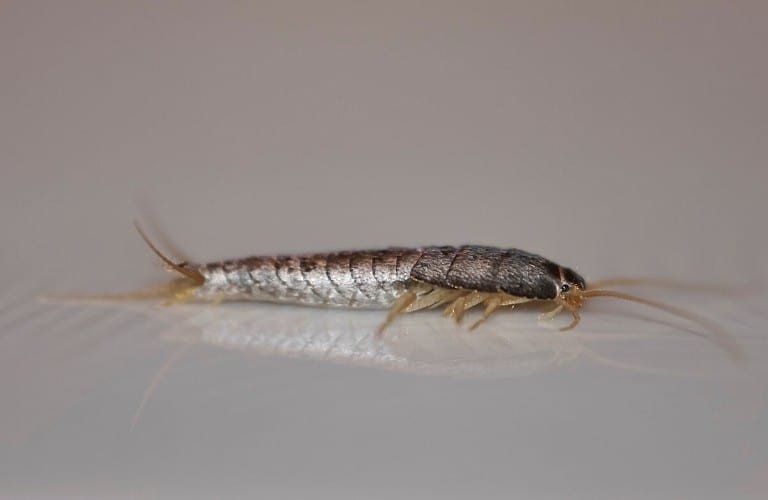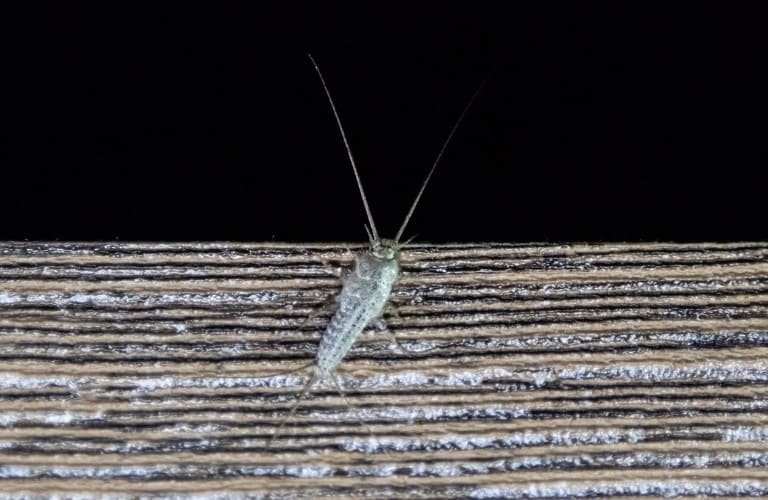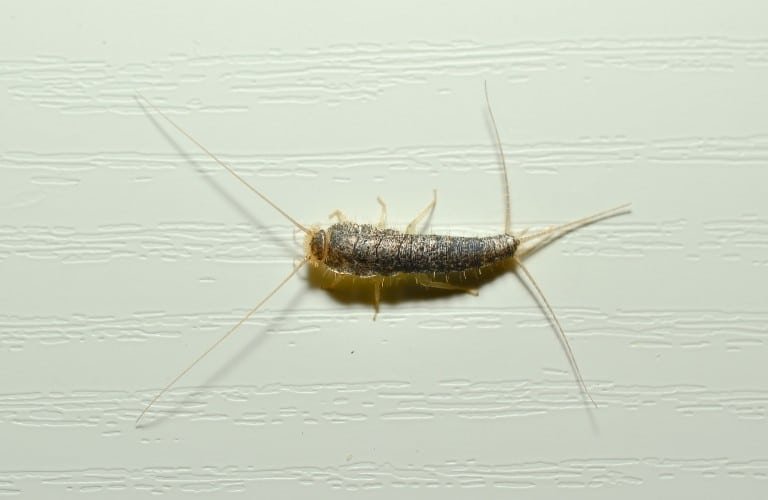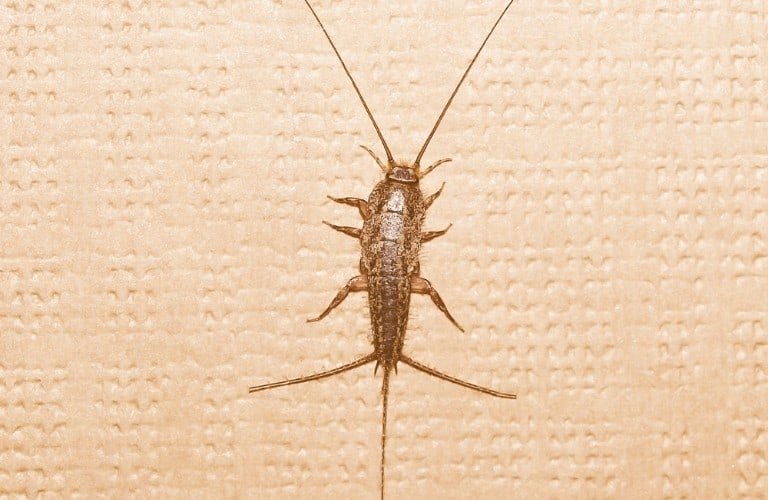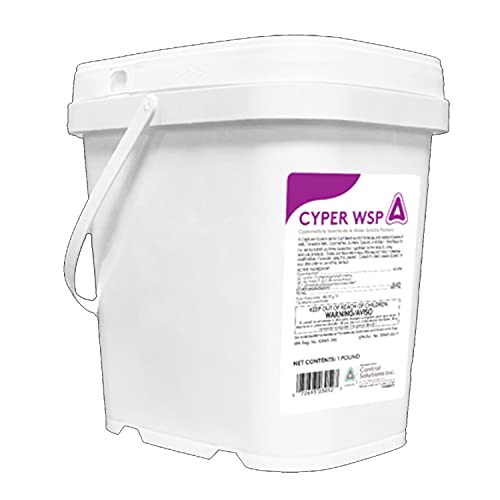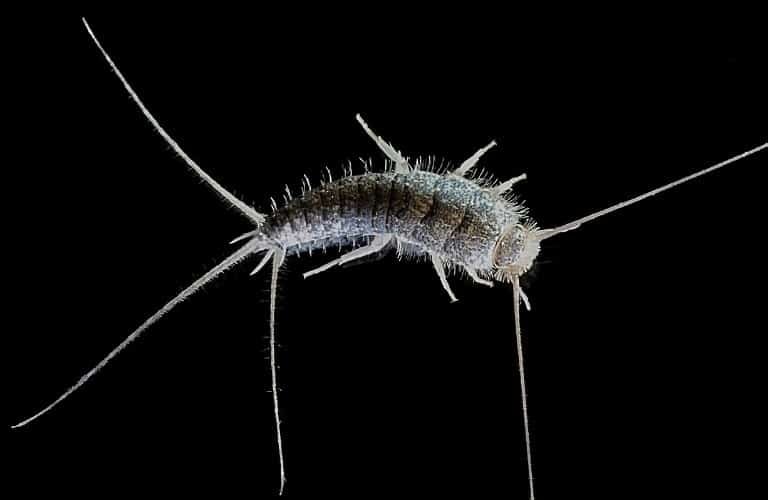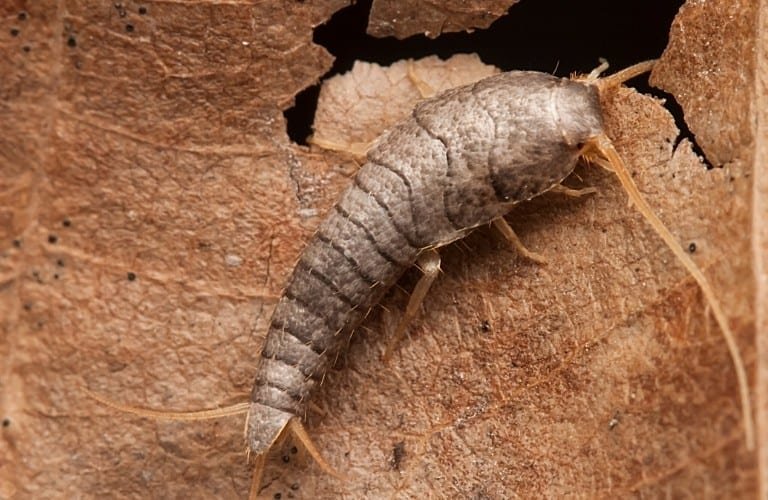Silverfish are insects that are hard to find because they’re nocturnal and hate any kind of light.
While you may not spot them with your own eyes, you can definitely see the evidence that they were there.
They like carbs and starches, and that unfortunately includes books and clothing.
How do you get rid of silverfish? Silverfish can be repelled with natural scents such as cedar and bay leaves or killed with diatomaceous earth or sticky traps. Alternatively, there are a variety of pesticides available. Maintaining clean, dry conditions will help make your home inhospitable to silverfish.
Identification
Many people scream when they see a silverfish, and rightly so.
They’re often described as prehistoric since they’re a scaly insect that moves around like a fish, with several little legs, long antennae, and cerci on their tail end, which look like tails.
Silverfish get their name from their silver backs. They start out as white when they’re young but eventually grow up to be gray or silver.
Since their scales are shimmery, they may look blue or brown in certain lighting.
Photos of silverfish are a bit misleading; they’re very small insects measuring between ½ and 1 inch long (13 – 25 millimeters).
Although there are six different types of silverfish, they are all quite similar in appearance with only slight variations in color.
You’ll most likely see them at night around books, clothes, dry foods in pantries, and pet food.
They can be found in almost every continent that has areas with at least 75% humidity, so don’t be too surprised if you spot one scurrying across your floors.
Find out how you might be attracting them here.
Ctenolepisma longicaudata (Gray Silverfish)
This kind of silverfish is known as a few different names including gray silverfish, long-tailed silverfish, and paper silverfish.
They’re similar to the typical silverfish mentioned above, but they look hairier and have a more speckled body that is brown and gray instead of solid gray.
They’re also found in almost every continent.
Commonly Mistaken Pest: The Firebrat
Firebrats are super similar to silverfish and are frequently referred to by that name.
The main differences are their striped gray and blackish-brown bodies and their requirement for high temperatures.
You’ll usually find them around water heaters and furnaces.
They won’t lay eggs unless it’s above 90°F (32°C) and are frequently found in bakeries since they provide the perfect mix of heat and carbs.
Removal Methods
| Method | Estimated Cost | Natural | Odor-Free |
| Cedar | $10+ | ✅ | |
| Diatomaceous earth | $10+ | ✅ | ✅ |
| Bay leaves | Less than $10 | ✅ | |
| Noninsecticidal traps | $20 | ✅ | ✅ |
| Insecticide liquid/spray | $70 | ✅ | |
| Insecticide dust | $15 | ✅ | |
| Insecticide aerosol | $25 | ||
| Granular bait | $25 | Yes, but harmful | ✅ |
The Best Way to Eliminate Silverfish
The best way to eliminate silverfish is with diatomaceous earth.
It’s inexpensive, only takes a few minutes to apply, and doesn’t cause any harm. It’s also free of odors so you won’t even notice it’s there.
Diatomaceous earth is a white powder made of fossilized algae.
The dust is harmless to humans (you can find it in some kinds of toothpaste), but it’s super sharp on insects’ exoskeletons.
As insects walk across it, it cuts open their exoskeleton and dries them out, causing them to die.
It will work excellently as a way to get rid of them, but it won’t prevent them or kill the eggs.
The silverfish must walk across the dust in order for it to be effective, so you’ll need to place it where the bugs are spotted the most.
Basic Guidelines
Of course, preventing silverfish from coming inside in the first place is ideal, but if you already have them, you naturally want them gone as soon as possible.
Silverfish can be quite destructive around books, clothes, and the pantry, so it’s important to keep them away from your home.
There are several ways you can go about making your home unappealing to silverfish, such as using bleach routinely (we discuss that in greater detail here).
The basic rule, however, is to keep everything clean and tidy.
Keep Your Home Dry
Silverfish love moisture; even the heat-loving firebrats love moisture.
If you have a silverfish problem, you probably have humid or damp areas in your home that you need to dry up.
Utilize dehumidifiers in humid rooms and repair leaking pipes.
If you frequently find silverfish in your shower or bathtub after you use it, you may need to dry it after you’re done.
You can use a fan in the bathroom to help dry it up faster.
Seal Your Starches
Silverfish love starches and carbs, so you need to keep these things sealed up tightly in air-tight containers (these Wildone Store containers are ideal).
This isn’t limited to food items, either. The following items are attractive to silverfish:
- Books.
- Glue.
- Clothing.
- Dry foods (pasta, cereal, grains).
- Pet food.
Keep clothing, books, sheets, and everything else silverfish like to eat in airtight containers like plastic bins that lock shut (like these).
Pantry items should be poured out of the package you bought them in and into a glass jar or plastic container that seals shut.
Canning jars are an excellent option and can be found on Amazon.
Keep It Tidy
Attics and closets are often filled with old things we don’t use on a daily basis, so they’re left in haphazard piles.
Piles of newspapers, magazines, clothes, and other similar items are prone to attracting silverfish.
These items don’t even have to be in rooms that are rarely visited – anything piled on the floor in a warm, humid room can house silverfish, even if it’s in your living room.
The best way to prevent them is to make sure there aren’t any piles of their favorite things on the ground.
Tidy your home frequently to make your home an unattractive dwelling to silverfish.
Natural Solutions to Get Rid of Silverfish
Silverfish can’t transmit diseases to humans, but they can destroy your stuff and frighten many people, which are good enough reasons to want to get rid of them.
Fortunately, there are several natural ways you can get rid of them without using harmful chemicals.
Indoor Solutions
Silverfish can be difficult to spot since they love hidden places in the dark.
These indoor solutions are perfect because they’ll be out of the way in the areas the silverfish like to hide in.
Cedar or Bay Leaves
Silverfish hate the smell of cedar. You can use cedarwood oil or cedarwood rings to deter the critters from your home.
You can place rings on hangers in your closet to keep them away from clothes or slip them into your clothes pockets. The small and flat size of them will allow them to fit almost anywhere. They’re non-toxic and also repel several other bugs including moths and ants.
If you happen to dislike the smell of cedar, you could opt to use bay leaves instead. Place a few dried bay leaves in your cabinets and any other area where you’ve spotted silverfish in the past.
There are other natural scents in the form of essential oils that effectively repel silverfish and may even kill them. You can find out more in this article.
Diatomaceous Earth
As mentioned earlier, diatomaceous earth is the best way to get rid of silverfish. There’s no odor or harmful ingredients so it’s safe to use around children and pets.
Sprinkle it around baseboards, in the attic, dark corners in the closet, or in your pantry.
The dust will kill the silverfish by cutting their exoskeleton and drying them out. You’ll find the dead silverfish on or near the powder since it kills them quickly.
Harris Food Grade Diatomaceous Earth is a good option because it comes with a duster inside of the bag for easy application.
It’s food-grade dust, so it’s perfectly safe to use in your pantry or around pets. The bag is resealable so you can use it again and again.
You’ll probably have to reapply it once a week for it to remain effective.
Noninsecticidal Sticky Traps
Sticky traps are an easy way to trap silverfish. You can set them up in hidden locations that silverfish love so you don’t have to see them.
Silverfish like glue because it’s starchy, so they’ll be attracted to most sticky traps even if it doesn’t have a scent or bait they like.
The GreenWay Spider & Silverfish Trap is a non-toxic option that’s safe to use around children and pets. The silverfish will stick to it until they die.
Once the trap is full, throw it away and replace it with a new one. It won’t be able to get rid of eggs, but it can get rid of small or fully-grown silverfish.
Best of all, it will also trap spiders and other insects that crawl across it.
This trap is effective, but there are also other trapping methods that can work equally well. Don’t miss viewing our top trap recommendations for silverfish.
Outdoor Solutions
Silverfish seem to be more common indoors, but they can also be an issue outdoors, as well.
The best natural way to get rid of silverfish is to make the environment uninhabitable for them.
Remove Real Estate
Silverfish are nocturnal and they run away from sunlight. This means that you’ll find them hiding under rocks or dark areas like piles of leaves.
If you find silverfish around your home, remove the places that they love to hide in.
They can easily come inside overnight when they like to be active, so if they can’t hide near your home, they can’t come in.
Remove Moisture
The places they like to hide are usually moist. Make sure there isn’t standing water in your yard or mud puddles sitting around for extended periods of time.
The following tips will help you keep your surroundings dry and silverfish free.
Remove Hiding Places Before Watering the Grass
Make sure lawn clippings and leaf piles are removed before you water the yard. Dark and humid areas are ideal locations for the bugs to hide.
Remove Standing Water
Many patios and sidewalks are uneven and cause water to pool up after it rains.
Remove these sources by pushing or blowing the water out with either a broom or a leaf blower.
Keep Outdoor Rugs Dry
Wet rugs are prime real estate for silverfish and since they’re usually kept by doors, they’re a great opportunity to attract them inside.
Bring in all rugs before it rains to prevent silverfish from claiming them as their own.
Seal Up Crevices
Silverfish can get inside through broken screens on doors and windows and cracks in your home.
Use caulk or weatherstripping to repair cracked areas in your home.
Just as air-tight containers will keep silverfish out of your food, a tight seal on your home will keep them out for good.
Pesticide Solutions to Get Rid of Silverfish
Natural solutions should always be your first attempt, but sometimes large infestations will require some chemicals.
Be very careful when using chemicals in your home as they can cause mild, severe, and occasionally lethal harm to people, pets, and the environment.
Insecticide Liquid: Cyper WSP
This insecticide is meant to be mixed with water and sprayed around your home.
There’s enough in the container to treat your home up to forty times, depending on if you follow the measurements and how much you have to spray your home with.
This product doesn’t have an odor and is super easy to use, but it does contain chemicals that will cause irritation or more severe effects if they’re ingested or come into contact with the skin.
It’s crucial that you wear protective gear when you use this.
It works great against silverfish and will keep them out of your home if you spray the outside of your house with it.
You can use it indoors but the area should be well ventilated.
Insecticide Dust: Cimexa
Cimexa is an excellent defense against silverfish and several other pests.
It works similarly to diatomaceous earth in that it kills them through dehydration. The powder sticks to their exoskeletons and slowly dries them out.
This product contains chemicals that are harmful, so you should be very careful when using it.
You can apply this in cracks and crevices where you typically find silverfish. Place it by baseboards, in corners, in walls, or wherever else you need it.
The dust is odorless and won’t cause staining, but it’s harmful if it’s ingested. It isn’t advised to put it in pantries or other areas where food is kept.
Insecticide Aerosol: PT 221L
Aerosol insecticides are one of the fastest ways to kill pests. You can use it indoors or outdoors – just spray it directly onto the pest when you see it.
It’s good for large infestations you want to get rid of quickly. It will work instantly and won’t provide long-term benefits.
This does have an odor that might be strong for some people. Some users say the odor is strong while others say it isn’t too noticeable.
If you have a sensitive nose, you might need to let the room ventilate overnight before returning if you use the spray indoors.
Aerosols are probably one of the most harmful insecticide options so they shouldn’t be used frequently.
They can irritate the eyes, nose, and throat while using them, and ingesting them can be harmful as well.
Be sure to ventilate the area you’re spraying and make sure your mouth and nose are covered.
Granular Bait: InTice
This granular bait kills silverfish by luring them to eat it. InTice contains boric acid which is a naturally occurring but harmful substance.
Once the silverfish eat the bait, they will die. Since the silverfish will eat the bait, you’ll need to apply it about once a week if you want to use it continually.
It can be used inside or outside but should be kept out of reach of children and pets.
It’s quite harmful so you should wear protective gear and avoid getting it on your clothes.
Thoroughly wash your hands and clothes before you touch anything else.
Safety Precautions When Using Pesticides
Pesticides and insecticides are toxic can cause harm ranging from mild irritation to death.
When using harmful chemicals to kill silverfish and other pests, you should follow these safety guidelines:
Wear Protective Gear
Wear gloves, goggles, long sleeve shirts, long pants, socks, and shoes. Cover your nose and mouth with a mask.
Protect Others
Don’t apply pesticides before giving everyone around you a proper warning.
Allow others to leave the room or yard before you begin applying it. Keep children and pets out of the area to keep them safe.
Ventilate the Area
It’s never safe to use pesticides in a closed space. Open windows and doors to prevent the fumes from building up.
If you breathe too many of them in, you risk harming yourself.
All these guidelines should be followed whether you’re using a liquid, aerosol, or dust. They’re all harmful and should be applied with great care.
It’s always safest to avoid pesticides altogether.
Try several different natural methods before turning to chemicals. If chemicals can kill bugs, they can cause you harm too.
When to Call a Professional Exterminator
Sometimes you can’t control a silverfish infestation on your own.
If you tried several natural methods and some pesticides but you’re still finding them in your house, it’s probably time to call a professional.
It’s possible you have a large infestation you don’t know about that needs to be tended to immediately.
You should also call a professional if you’re unsure of how to use pesticides.
Exterminators know how to safely and effectively use pesticides, so they’re a great way to take care of your pest problem without causing any harm to your household.
If you’re like others who are dealing with a silverfish problem, you likely have more questions and could benefit from additional prevention and elimination tips.
Head over to our list of silverfish articles to find the answers to your questions so that your silverfish situation can quickly become a thing of the past.

